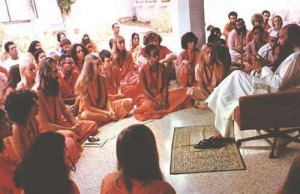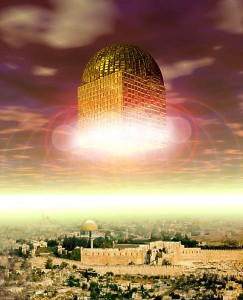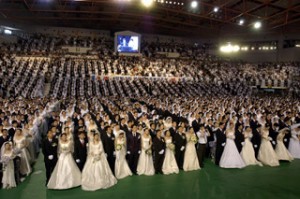No matter how they dress themselves up – saffron dhotis, long white robes, business suits or mufti – organizations built around prophets and messiahs tend to have several critical features in common.

First, prophetic/messianic movements tend to be apocalyptic in nature, even if that end-of-the-world mindset masquerades as something else. The formal definition of “apocalypse” technically refers only to a “revelation”, as in the last book of the Bible, but it has gained the connotation of a doomsday event, “the end of the world as we know it”, which most of us would consider to be a monumentally bad thing. “Post-apocalyptic” conjures up images of ruined cities and anarchy, of Road Warrior Mel Gibson at war with bloodthirsty barbarians in souped-up combat vehicles and funky leather, or Kevin Costner in the aquatic version of the same. Meantime, post-apocalyptically, we imagine that most of us would be either dead, subject to brutal warlords, or back in the stone age. However, a messianic movement turns that fearful vision on its head.
To a messianic movement, the apocalypse is not just inevitable and necessary, but also desirable. It is something to be anticipated and welcomed, perhaps even encouraged to happen. Whether it comes in the form of nuclear conflict, global climate change, a pandemic, a neocon economic “adjustment”, or simply the generalized Wrath of God, it will clear away an old order that is hopelessly sinful and flawed—God’s spring cleaning. It will be followed, not by the desperate stone-age barbarism envisioned by the rest of us, but by a shining new order, indeed a new heaven and earth, populated by the righteous survivors, and rebuilt upon righteous principles to be a heaven on earth. The messiah is not only the promised one who will bring his faithful safely through doomsday, but the one who will determine the shape of the New Order.
This kind of vision is called “millenarian”, a term that goes hand in hand with apocalyptic fervor. Again and again, we see prophets and messiahs crying doom on one hand, and promising the one true path to salvation on the other. Or, in a common variant, the messiah gathers his following among the oppressed or disadvantaged, promising that the fat bastards on top will be destroyed, while the meek (i.e, his flock) will inherit the earth. Either way, the faithful can deal comfortably with both present injustice and fear of the future, because their messiah has promised they will come out just fine—if they do what he says.
It is important to stress that the specific details of the “end of the world” are highly variable. God or the gods, Mother Nature herself, cosmic forces, economic meltdown, bankruptcy of large corporations, all manner of space aliens or other-dimensional intelligences, may be involved. What they share is a general similarity in how all these agents of apocalypse affect the believers, and how useful they are to the messiahs.
A second standard feature of messianic movements is that they are divisive. That is, they separate the world firmly into two opposing camps: the faithful, and everybody else. Good and evil. Saved and damned. Aryan and subhuman. Followers and infidels. Brand X and Brand Y. Followers are expected to cut ties with unbelievers, even if that means disowning families and friends who fail to join up too. Apostates, meaning those who leave the movement and join the “other side”, are particularly reviled, and may become the target of dirty tricks, slurs, and even death sentences. This division is reinforced by the way such movements typically control information from and contacts with the outside world, a fortress mentality that may even includes a literal move into the wilderness. Information that does manage to fight its way through is demonized and discounted. Effectively, the messianic movement becomes a hermetically sealed environment, within which the messiah’s pronouncements may make good sense, but where any form of reality testing is impossible.
Third, messianic organizations are hierarchical, organized in a markedly top-down fashion, with the prophet or messiah or pontiff or dictator-for-life at the pinnacle, an elite cadre of trusted lieutenants on the next step, and then the hoi polloi or huddled masses of true believers at the bottom. The power structure is safeguarded and maintained by a high degree of authoritarianism, with loyalty directed upwards rather than sideways to peers, and there are penalties for breaking a wide range of rules and demands. Typically, however, those rules do not apply to the upper echelon, and particularly not to the guy at the top.
Notably, there is often tight control of the followers’ sexuality. This takes many forms, all the way from banning sex altogether, to micromanaging who is required to have sex with whom. But again, this control may not apply to the elite group. In a thought-provoking number of cases, one of the perks of being at the top or in the inner circle is total sexual license, and access to the sexual services of any and all members of the lower echelons. This marks another irresistible parallel with the social organization of some of our sibling species, the other great apes.
Similarly, followers will usually be required to be ascetic—to deny themselves luxuries and live spartan, hardworking lives; to contribute time and money to the movement; and to embrace hardship as the price of being associated with the messiah, and in line for salvation. Once again, this most frequently does not apply to the elite, who tend to do rather well for themselves materially. Think of the televangelists’ flashy homes, the huge incomes of corporate CEOs, the Baghwan’s fleet of Rolls Royces, and the shoe collection of Imelda Marcos. And if the disparity seems outrageous to outside observers, the true believers are generally prevented from protesting by psychological mechanisms of cognitive dissonance and denial.
Cognitive dissonance and denial are complex mechanisms, but together they boil down to the odd fact that, even if the subjects notice the boss has feet of clay, or see a mismatch between the boss’s version of reality and what their own intelligence tells them, they will close their eyes to the difference. That is, they are prone to rationalize the mismatch, and persist in their faith because – after they have invested so much of themselves in that belief – some part of them needs the messiah and his promises to be true. We will look at examples, some of them dramatic, of these mechanisms in action.
One final comment: the aftermath. What happens to messianic organizations? A social organization built around one man’s appeal—be it a cult or a state—is inherently unstable. For one thing, messiahs often become the victims of their own propaganda. As their sense of grandeur is reinforced by the power they wield, they commonly get farther and farther out of touch with both their followers and with reality in general. And then, if an unenchanted universe issues a reality check that cannot be ignored or evaded, the whole house of cards may fall apart, as it did at Jonestown, Berlin, and many other places. Or if the central prophecy does not come to pass—if the world does not end on schedule, the mothership does not land, the messiah is arrested or absconds, or dies of appendicitis before he can become king of the world—what then?
Rather than collapsing, such organizations may morph, sometimes into respectable institutions, states or religions that, after a long time, retain few traces of their messianic, millenarian origins. Max Weber calls this “routinization”: the process of becoming routine, or part of the cultural mainstream, and it has a better chance of happening if a there is a secondary messiah to don the fallen leader’s mantle. But one of the most curious features of all is that the failure of a prophecy, or the downfall of a prophet, may strengthen a movement, not destroy it.
Next installment: some examples from the deep past.


